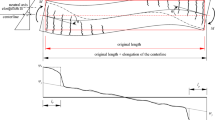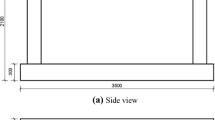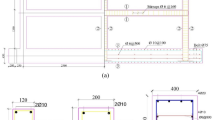Abstract
This paper presents an experimental study of the behavior of partially concrete encased steel beams (PE beams) under seismic loading. The effects of a floor slab in providing lateral and torsional support to the strength and ductility of the beam are also investigated herein. One steel beam and six PE beams were tested herein. The strength development in bare steel beam was insufficient and significant lateral torsional buckling (LTB) was observed. The concrete encasement of the PE beam delayed the occurrence of LTB and hence increased the strength and ductility of the beam. The plastic rotation capacity of PE beam is enhanced by the additional lateral and torsional support provided on the top of a PE beam. For the beam tested in this study, the concrete encasement permits the beam to reach its plastic strength and have plastic rotation of at least 3.42% rad, which is larger than 2% rad required for Intermediate Moment Frames, when no lateral or torsional support is provided at the top of the beam. To satisfy the 4% rad plastic rotation limitation for special moment frames, lateral support with sufficient torsional stiffness is needed.



















Similar content being viewed by others

References
ACI. (2014). Building code requirement for structural concrete ACI 318-99 . Farmington Hills: American Concrete Institute.
ANSI, AISC 341-16. (2016). Seismic provision for structural steel buildings. Chicago: American Institute of Steel Construction.
ANSI, AISC 360–16. (2016). Specification for structural steel buildings. Chicago: American Institute of Steel Construction.
Chen, S. J. (2001). Design of ductile seismic moment connection, increased beam section method and reduced beam section method. International Journal of Steel Structures, 1, 45–52.
Chen, S. J., Yeh, C. H., & Chu, J. M. (1996). Ductile steel beam-to-column connection for seismic resistance. Journal of Structural Engineering, ASCE, 122(11), 95–119.
Chen, Y., Li, W., & Fang, C. (2017). Performance of partially encased composite beams under static and cyclic bending. Structures, 9, 29–40.
De Nardin, S., & El Debs, A. L. H. (2009). Study of partially encased composite beams with innovative position of stud bolts. Journal of Constructional Steel Research, 65(2), 342–350.
Hegger J., & Goralski C. (2005). Structural behavior of partially concrete encased composite sections with high strength concrete. In Proceedings of the 5th international conference in composite construction in steel and concrete (pp. 346–355), South Africa.
Itani, A. M., Cheng, Z., & Saiidi, M. (2004). Cyclic response of steel moment connection for large beam sections using haunch and reduced beam section concepts. International Journal of Steel Structures, 4, 147–155.
Jiang, Y., Hu, X., Hong, W., Gu, M., & Sun, W. (2017). Investigation on partially concrete encased composite beams under hogging moment. Advances in Structural Engineering, 20(3), 461–470.
Jin, J., & El-Tawil, S. (2005). Seismic performance of steel frames with reduced beam section connections. Journal of Constructional Steel Research, 61, 453–471.
Kindmann, R., Bergmann, R., Cajot, L.-G., & Scleich, J. B. (1993). Effect of reinforced concrete between the flanges of the steel profile of partially encased composite beams. Journal of Constructional Steel Research, 27(1–3), 107–122.
Kodaira, A., Fujinaka, H., Ohashi, H., & Nishimura, T. (2004). Fire resistance of composite beams composed of rolled steel profile concreted between flanges. Fire Science and Technology, 23(3), 192–208.
Lindner J. & Budassis N. (2000). Lateral torsional buckling of partially encased composite beams without concrete slab. In Proceedings of composite construction in steel and concrete IV conference, The United Engineering Foundation ASCE (pp. 117–128), Canada.
Nakamura, S., & Narita, N. (2003). Bending and shear strengths of partially encased composite I-girders. Journal of Constructional Steel Research, 59, 1435–1453.
Piloto P. A. G., Gavilan A. B. R., Mesquita L. M. R., & Goncalves C. (2012). High temperature tests on partially encased beams. In Proceedings of the 7th international conference on structures in fire, Zurich, Switzerland.
Piloto, P. A. G., Gavilan, A. B. R., Zipponi, M., Marini, A., Mesquita, L. M. R., & Plizzari, G. (2013). Experimental investigation of the fire resistance of partially encased beams. Journal of Constructional Steel Research, 80, 121–137.
Plumier, A. (1994). Behavior of connections. Journal of Constructional Steel Research, 29, 95–119.
Author information
Authors and Affiliations
Corresponding author
Rights and permissions
About this article
Cite this article
Chen, CC., Sudibyo, T. & Erwin Behavior of Partially Concrete Encased Steel Beams Under Cyclic Loading. Int J Steel Struct 19, 255–268 (2019). https://doi.org/10.1007/s13296-018-0114-y
Received:
Accepted:
Published:
Issue Date:
DOI: https://doi.org/10.1007/s13296-018-0114-y



